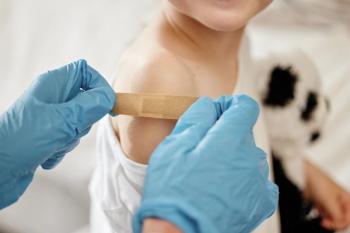
- September 2023 Immunization Guide for Pharmacists
Ensuring Health Equity in Vaccination Access: How Pharmacies Can Work With Community Organizations
Community pharmacies and organizations can collaborate to tailor strategies and interventions and address the challenges and specific needs of the community.
The COVID-19 pandemic did not weigh equally on all community groups. Rather, some populations were impacted more than others. This disproportionate burden of COVID-19 infection created new gaps in the health care system and highlighted existing ones. This was especially true regarding COVID-19–vaccination access and acceptance, resulting in racial and ethnic minority groups who were less likely to be vaccinated (Table).1
One of the greatest impacts that community pharmacists made during the COVID-19 pandemic was provision of immunizations. As of July 21, 2023, staff at pharmacies administered more than 305.5 million doses of COVID-19 vaccines; this includes 8 million doses administered onsite at long-term care facilities during the pandemic.2 Developing innovative models to address health care disparities and inequalities are key to optimizing population health. This article describes how community pharmacies can connect with community organizations to promote equity in vaccine access and increase vaccination rates. Lessons learned from the COVID-19 pandemic can be applied to the administration of current and new vaccines.
Establishing Effective Community Partnership
Pharmacy staff working with community partners can tailor strategies and interventions to address the challenges and specific needs of the community and to increase vaccine access and immunization rates (Figure).3 Specific considerations include:
- sharing information and materials (eg, vaccine efficacy and possible adverse events, clinic locations) with community members;
- determining the best methods and platforms (eg, interviews with trusted leaders, faith leaders, or celebrities; billboards; local media [TV or radio stations]; print media) to share information with community members;
- identifying appropriate venues and locations (eg, grocery stores, churches, schools, barbershops, local pharmacies) for outreach;
- deciding who are trusted messengers (eg, faith leaders or vaccine administrators of the same race/ethnicity as those in the community) to share information and administer vaccines to community members; and
- maximizing site logistics, which may increase access to vaccine clinics for community members and allow vaccination to be bundled with other services.
Information and Materials
Vaccine information should be transparent, promote the benefits of and reasons for immunization, and address potential risks of the vaccine in a culturally relevant manner.3 Information should be provided in English and the predominant language spoken within the community. Undocumented or uninsured patients may avoid vaccination due to concern about language accessibility, insurance requirements, and immigration status.
During the fall of 2022, which coincided with the peak of the harvest season in Idaho, pharmacy professionals established an outreach program to vaccinate the migrant farm worker community against COVID-19.4 They developed a multicomponent media campaign in Spanish. The pharmacy staff advertised extended hours in Spanish on radio stations and billboards to accommodate workers’ schedules. They also established a partnership with the Idaho State University College of Pharmacy involving student pharmacists assisting with COVID-19 vaccination. In addition, all immunization paperwork was made available in Spanish, and a Spanish interpreter was available at the pharmacy to describe the immunization process and answer any questions. This successful program resulted in dozens of migrant workers receiving COVID-19 vaccines.
Methods and Platforms
Vaccine information should be disseminated through a variety of different media and sources.3 This can include written materials (eg, flyers, postcards, advertisements), social media graphics and information (eg, Facebook, Twitter), online platforms (eg, newsletters, listservs), text messages, and in-person opportunities for community dialogue (eg, town hall meetings, question and answer sessions, small group discussions).
A Nigerian-American pharmacist in Indiana used social media to provide culturally-relevant COVID-19–vaccine information during the pandemic.5 She used social media to address vaccine hesitancy and vaccine-related concerns of people in the community who are often underserved or underrepresented (eg, Black and African-American individuals, residents of urban areas, people who are socioeconomically disadvantaged). Using her personal and professional experience, she provided online educational resources to her followers, who likely did not have access to such information. She provided patient-friendly, evidence-based information from trusted scientific experts who also came from minority backgrounds to help her followers make their own educated decisions. As a result, she was able to reach thousands of people about the importance of COVID-19 vaccination through her social media efforts.
Venues and Locations
Vaccine information should be provided in places frequented by community members.3 These locations can include community-wide areas, such as grocery stores, recreation centers, libraries, schools, and faith-based communities. In addition, health-specific areas (eg, pharmacies, medical clinics, health systems) should be used for vaccine information and administration.
Faith-based institutions have a wide reach in the community, and they may serve as a venue for vaccine clinics. Churches can offer use of larger capacity facilities (eg, halls, gyms), parking lots, and volunteers. Pastors can be trusted messengers in racial or ethnic minority group communities. Local churches can be used to host influenza vaccine clinics each fall.
During the COVID-19 pandemic, a pharmacy in North Carolina partnered with local churches to host COVID-19–vaccine clinics at their houses of worship.6 As part of the immunization effort, local pastors emailed congregants or knocked on doors to inform them about upcoming vaccine clinics. To reach more people, the pharmacist worked with the local housing authority; social workers went door-to-door to inform residents about upcoming clinics and schedule appointments. In addition, the pharmacist worked with local physician groups to identify and vaccinate homebound residents. By April 2021, these efforts resulted in the vaccination of over 40,000 people in North Carolina and Virginia.
Local food pantries are another trusted community partner. During the pandemic, a pharmacy in Iowa collaborated with a local food pantry to host a COVID-19–vaccination clinic.7 Staff at the pharmacist-run clinic administered more than 600 COVID-19 vaccines in 1 day; as of May 2021, more than 35,000 people were immunized as a result of this collaboration. Many patients may not have received a COVID-19 vaccine otherwise, as they were members of socioeconomically disadvantaged groups, did not speak English, and/or were undocumented individuals.
Trusted Messengers
Vaccine information should be provided by messengers who represent the community and provide a positive influence. Trusted messengers can include local radio and TV personalities, celebrities and leaders from community, faith-based, or civil rights organizations; government; and businesses who engage with the community and have their trust and support.3 In addition, health care messengers (eg, local providers; staff from health clinics, pharmacies, and health systems) should provide vaccine information and administration.
Black individuals are twice as likely to trust a messenger from their own racial or ethnic group in their community as are their White counterparts.3 The social hub of the barbershop in the Black community and the trusted relationship between barber and client has been used to successfully provide health screening and education. In 2018, a mobile booking app for barbershops evolved into Live Chair Health, an initiative designed to reduce health disparities among people of color and to address chronic health issues that disproportionally affect Black individuals.8 During the pandemic, the Live Chair Health program trained staff at more than 50 barbershops on the East Coast about the symptoms of COVID-19 infection and the advantages of receiving vaccines. The barbers used their connection with clients to share accurate information, dispel misinformation, and help clients make informed decisions about their health. Local community pharmacists could educate barbers; in turn, barbers could refer their clients to the pharmacist for their vaccination needs. In addition, barbershops could be used to host influenza vaccine clinics each fall.
As another example, in 2020, a tribal-owned health system in Arizona relied on trusted residents and health providers of the Navajo Nation to address specific COVID-19 vaccine–related concerns.9 Members of the Tuba City Regional Health Care Corporation health system surveyed unvaccinated members of the Navajo Nation each week to determine their reasons for not receiving the vaccine. The team then tailored written materials and social media video posts to address those specific concerns. Providers from the health system answered questions in real time on Facebook Live. Once again, having vaccine workers and messengers who share the same race/ethnicity of community members can promote vaccine acceptance.
Site Logistics
Community pharmacies are a convenient location for patients to obtain a variety of patient care services. Approximately 90% of the United States population lives within 5 miles of a community pharmacy.10 When other health care settings are typically closed, a number of community pharmacies are open on nights and weekends to provide improved public access to vaccines and other patient care services.
When transportation to the pharmacy is a barrier for patients, community organizations and faith-based communities can help. During the pandemic, county officials in Fairfax, Virginia, created the Vaccine Transportation Program.11,12 The county provided free taxi rides to residents who had an appointment to receive the COVID-19 vaccine but no access to transportation. In addition, the county provided information and links on their website about other transportation services offered via community partners and faith-based communities.
Other transportation efforts were conducted on a much larger scale during the COVID-19 pandemic. At the height of COVID-19–vaccination initiatives, Uber provided 10 million free and discounted rides to and from COVID-19–vaccine centers.13
Conclusions
The crucial role that community pharmacists play in the health care system to address patient care gaps was emphasized during the COVID-19 pandemic. Community pharmacists are highly visible health care providers who are readily accessible to the public. These pharmacists have the opportunity to address health disparities and inequalities to optimize population health. To increase vaccine access and immunization rates, community pharmacies and organizations can collaborate to tailor strategies and interventions and address the challenges and specific needs of the community.
About the Author
Miranda Wilhelm, PharmD, is a clinical professor in the department of pharmacy practice at the Southern Illinois University Edwardsville (SIUE) School of Pharmacy and a clinical pharmacist with SIUE Health Service in Edwardsville, Illinois.
References
- COVID data tracker: trends in demographic characteristics of people receiving COVID-19 vaccinations in the United States. CDC. Updated May 11, 2023. Accessed June 17, 2023. https://covid.cdc.gov/covid-datatracker/#vaccination-demographics-trends
- Vaccines & immunizations: the federal retail pharmacy program for COVID-19 vaccination. CDC. Reviewed July 25, 2023. Accessed July 27, 2023. https://www.cdc.gov/vaccines/covid-19/retail-pharmacy-program/index.html
- A guide for community partners: increasing COVID-19 vaccine update among members of racial and ethnic minority communities. US Department of Health and Human Services/CDC National Center for Immunization and Respiratory Diseases. CDC. April 6, 2021. Accessed July 1, 2023. https://www.cdc.gov/vaccines/covid-19/downloads/guidecommunity-partners.pdf
- Collins S. VaccineConfident: Community pharmacist connects with hard-to-reach population. American Pharmacists Association. April 2023. Accessed July 1, 2023. https://vaccineconfident.pharmacist.com/Success-Stories/Articles/Community-Pharmacist-Connects-With-Hard-to-Reach-Population
- Chan C. VaccineConfident: Pharmacist leads by example and uses social media to educate her community. American Pharmacists Association. April 2021. Accessed July 1, 2023. https://vaccineconfident.pharmacist.com/Success-Stories/Articles/Pharmacist-Leads-by-Example-and-Uses-Social-Media
- Collins S. VaccineConfident: Pharmacist partners with faith-based communities to provide COVID-19 vaccinations. American Pharmacists Association. April 2021. Accessed July 1, 2023. https://vaccineconfident.pharmacist.com/Success-Stories/Articles/Vaccine-Confident-Pharmacist-North-Carolina
- Chan C. VaccineConfident: Putting people at ease by providing vaccines at familiar community locations. American Pharmacists Association. May 2021. Accessed July 1, 2023. https://vaccineconfident.pharmacist.com/Success-Stories/Articles/Putting-People-at-Ease-by-Providing-Vaccines-at-Familiar-Community-Locations
- Perlow B, Moton K. Barbershops in Black communities provide information on COVID-19, vaccine. Live Chair Health trains barbers to address health disparities. ABC News. January 12, 2021. Accessed July 1, 2023. https://abcnews.go.com/Politics/barbershops-black-communitiesprovide-information-covid-19-vaccine/story?id=75198074
- Collins S. VaccineConfident: Tribal pharmacist addresses individual concerns and appeals to cultural values, American Pharmacists Association. July 2021. Accessed July 1, 2023. https://vaccineconfident. pharmacist.com/Success-Stories/Articles/Tribal-Pharmacist-Addresses-Individual-Concerns-and-Appeals-to-Cultural-Values
- Berenbrok LA, Tang S, Gabriel N, et al. Access to community pharmacies: a nationwide geographic information systems cross-sectional analysis. J Am Pharm Assoc. 2022;62:1816-1822.e2. doi:10.1016/j.japh.2022.07.003
- Fairfax County Health and Human Services COVID-19 response updates. FairfaxCounty.gov. December 2022. Accessed July 1, 2023. https://www.fairfaxcounty.gov/neighborhood-community-services/sites/neighborhood-community-services/files/assets/documents/coronavirus/hhs-update.pdf
- Need help getting to your COVID-19 vaccine appointment? View several transportation options. Fairfax County Emergency Information. March 1, 2021. Accessed July 1, 2023. https://fairfaxcountyemergency.wpcomstaging.com/2021/03/01/need-help-getting-to-your-covid-19-vaccineappointment-view-several-transportation-options/
- Uber Impact. Rides for vaccinations. Uber. Accessed July 1, 2023. https://www.uber.com/us/en/impact/rides-for-vaccines/
Articles in this issue
Newsletter
Stay informed on drug updates, treatment guidelines, and pharmacy practice trends—subscribe to Pharmacy Times for weekly clinical insights.














































































































































































































